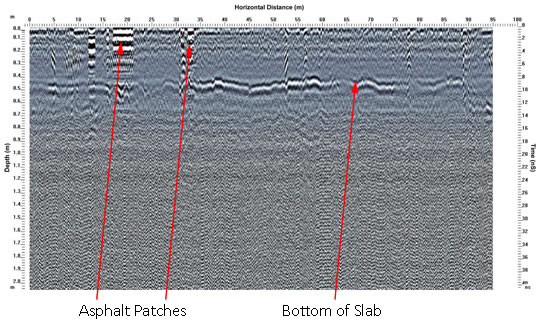
Background
An engineering firm retained multiVIEW to perform a geophysical survey. The objective of the survey was to delineate the spatial position of any possible voids underneath a slab-on-grade concrete floor.
The information was used by the engineering firm to assist with their investigation of the site. The survey area measured approximately 100 by 35m.
Methodology – Void detection
A survey grid was installed on 5m centers across the site using survey tapes, a right-angle prism and line of-sight positioning. Grid nodes were marked with water based orange paint.
The survey was conducted twice using two antenna frequencies (500 and 1000MHz) to permit optimum penetration depth and resolution. The radar profiles were collected across the site using a 1.0m line spacing and a 5cm station spacing, in both east-west and north-south line directions.
Depth slice maps were produced by modeling and interpolating the data between a series of adjacent lines to provide a plan view renderings of the received GPR signal strength, averaged through a discrete depth range.
Findings
Figure 1 displays a 1000MHz depth slice plot from 75 to 100mm which shows the high amplitude responses detected across asphalt patches and surfaces. Brighter (i.e. red, orange, yellow) colour contours represent stronger signal amplitudes (strong reflectivity). Green and blue colours represent progressively weaker radar reflectivity.

Figure 2 displays a 1000MHz GPR profile which shows the high amplitude responses detected across asphalt patches and surfaces. A strong horizontal reflection is also noted at a depth of approximately 400 to 450mm. Based on the depth of this response it is likely a reflection at the interface of the bottom of the concrete slab and underlying base material.

Figure 3 shows two anomalous zones of high amplitude GPR responses. The higher amplitude responses detected in the material beneath the outlined anomaly could indicate a change in the sub base material or a void. There were no anomalous high amplitude responses detected within the concrete slabs.
